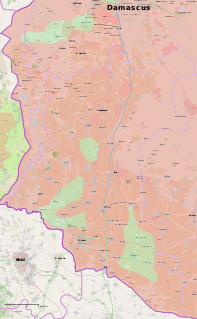History
In late 2012, the first rebel group in the town, the "Al-Sanamayn Revolutionaries Battalion" was formed. [6]
In early 2013, a rash of defections took place in the town, which was located on a strategic highway. [8] Rebels would take over multiple areas of the city. The Syrian government remained in control of the military and security branches, main roads, heavily defended checkpoints such as the Qiyetah junction, and all military sites. [9]
On 10 April 2013, the Syrian Army launched an assault on the city targeting the southern areas. [6] The Syrian armed targeted the city with artillery and rocket fire from barracks outside the city as they prepared to storm the city with heavy weapons. [9] All roads leading in and out of the city were closed. The Syrian Army, accompanied by Hezbollah and pro-government militias, stormed the town and battled their way to the city center, forcing rebel forces to withdraw from the areas. [9] 20 houses were destroyed and at least 45 people were killed in Sanamayn alone [5] in what was described as a massacre by opposition activists. The town of Ghabagheb, north of Sanamayn, was also stormed. 16 rebels were killed in fighting in the two towns according to the Syrian Observatory for Human Rights. [8] Some listed the death count in Sanamayn as high as 60. [10]
Despite the operation, rebels would continue to have a presence in Sanamayn. More groups would emerge in the town with light and medium weapons. Although the rebels were present in multiple areas of the city, the Syrian government once again remained in control of the important military checkpoints and sites, such as the base of the 9th Division, [4] and the roads passing through the city. [6]
Two local councils would be formed by the opposition in rebel-held areas of the town. The first was announced in August 2013, and later joined the Union of Local Councils in Daraa Province. The second was announced in November, headed by Yassin al-Atmeh, and linked through connections with other Daraa councils to the Syrian Interim Government. [6] Despite this, the rebel-held neighborhoods of Sanamayn were mainly reliant on the Syrian government for most public services, with the local councils only able to oversee the distributions of gifts and aid on certain occasions. [6] Due to this, and to the fact that the number of opposition fighters in the city was very small, the rebels in Sanamayn failed to play a significant role in the Daraa Governorate campaign.
Skirmishes and clashes would take place between the two sides, with rebels launching attacks on the military and security sites, leading on occasion to escalations such as shelling. [6]
In December 2015, four civilians were reportedly killed in the town due to shelling, although it could not be verified whether or not this came from the Syrian Army or rebels in the Southern Front targeting pro-government sites in the area. [11]
In December 2015, the Syrian Army imposed a blockade on the rebel-held neighborhoods of Sanamayn in response for the factions carrying out an attack on a car carrying an officer and several soldiers. Negotiations took place between the Syrian Army and rebel factions resulting in a ceasefire between the two sides. [6]
In December 2016, in response to the theft of government property by a corrupt leader of a rebel faction, the Syrian Army once again besieged the rebel-held neighborhoods of Sanamayn and pressed for a reconciliation agreement. [6] Under the terms, the rebels were to confiscate their weapons and pledge not to carry out any attacks, as well as join the regular forces or the Russian-led 5th corps. [4] The rebels were divided on whether to negotiate or respond militarily to the Syrian Army's actions. During the siege, rebel fire from the Southern Front targeted government-held areas, leading to civilian casualties. [6]
In the end, 510 people, including 150 rebels, accepted the reconciliation agreement, and Sanamayn came under full government control.










